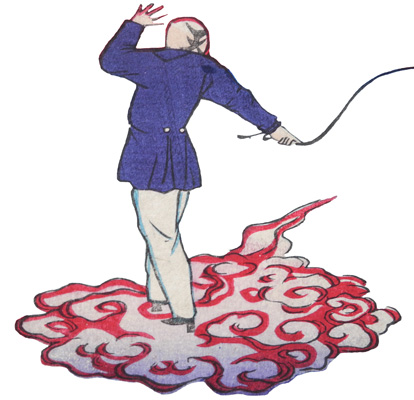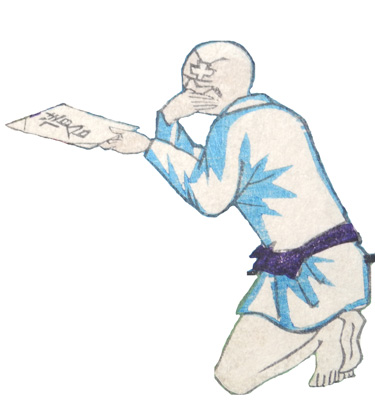About This Print
Sources: Guy Pepermans (via the bulletin board Ukiyo-e Q&A, who was kind enough to provide me with the basic story behind this print also confirming the artist as Hiroshige III, and follow up emails) and as footnoted below.This print was likely issued as a nishiki-e shinbun (newspaper woodblock print) just before the release of the actor Arashi Rikaku III (嵐璃鶴) from jail in September 1874 for the March 1871 murder, by arsenic poisoning, of the money lender Kobayashi Kinpei, the patron of Rikaku's lover, the beautiful geisha Harada Kinu 原田 絹 [aka Harada Okinu and Yoarashi (夜嵐 night storm) Okinu.]
Of course, the newspapers had a field day with the murder which became part of the genre of dokufu, so-called “poison women” tales. This case not only generated newspaper stories and prints but also a book by the journalist and gōkan writer Okamoto Kisen, titled Night Storm Okinu’s Flowery Dream of Revenge (Yoarashi Okinu hana do ada-yume, 1878) based on a poem Harada recited before her beheading.1
As the story goes Harada conspired with Arashi Rikaku III, by whom she was five months pregnant, to kill her patron Kobayashi Kinpei. Within several months they were both arrested2, tried and sentenced to death. While awaiting execution, Rikaku's sentence was commuted to three years in prison because his "crime had been deemed insufficiently serious enough to warrant capital punishment" but Okinu was told "For having committed a capital crime a while ago your sentence is still in effect and at this time you are expected to cross the Sanzu River.." (the Buddhist equivalent of crossing the River Styx.)3 However, the government delayed her execution to allow her to give birth.
On February 20, 18724, Okinu’s head was cut off at the Kodukahara execution grounds, and displayed in public for several days. Rikakau was released from prison in September 1874 and went back to the kabuki theater where he rebuilt his career as the actor Ichikawa Gonjurō II, dying of pneumonia in 1904.
Three akudama's and a single zendama occupy the diptych representing evil and good. For the origin of these zendama and akudama figures please see the article on this site titled Representations of Good and Evil: Origins of Zendama and Akudama Figures in Japanese Prints.
 |  |
| Good 善 Zendama | Evil 悪 Akudama |
Transcription of the Story on the Print
Source: With thanks to Yajifun http://yajifun.tumblr.com/post/95272795070/the-true-story-of-arashi-from-osaka-hiroshige
"外面如菩薩内心夜叉実に恐るべきハ惡婦なり茲に明治三年夏の頃猿若町の新道に某の囲女にて原田於絹と云者あり生得(ついて)の淫婦にて近隣の俳優と奸通なす事數度なり一時嵐璃鶴を見初是が宅へ往来し楮幣を投じ遂に其情欲をとげつゝも水洩さじと契りける璃寉其折廿二才つく/゛\と思やうたとへ囲女なれバ迚(とて)夫ある者と通る事世間の聞へも如何なりと一夜彼女に對(むか)ひ右の故以て云出けるに然らバ夫さへなくバわらハを妻となし給ふや成ほど御身獨身ならバ誰人に憚るべき妻となさんと一寸退れ約定なしてわかれけるが程なく新しき年を迎へ世間ハ春めく賑ひも於絹が東?家(だんな)ハ?冬より風邪の心地と打臥けるが次第に重る惡念の藥に混交る鼠捕いたづら者と云バいへ思ふ男と添とげんと地獄落しの惡計に毒殺なせしハ維旹(ときにこれ)明治四年の正月にて同二月駒形町へ轉宅なし然して璃鶴を宅へ招き先頃約定なしたるごとく当時ハ夫なき身の上何卒妻となし給ハれ尤(もつとも)夫ハ斯々なし毒薬を以て殺したり否と云バ御身も殺し我も此場で自害せんとかくせし短刀抜ひらめかし威して男を往生づくめ恩義もあれバ其まゝに過去中に其年七月惡事忽ち露顕なし廿九才を一期として女ハ梟首璃鶴ハ懲役三年の苦役を勤め今般御宥し蒙しとぞ”
“悪玉「サア/\おやかたかやの中へおはいんなせへよ 淫婦原田絹女「モシおやかたおまへさんとふうふになれバわたしやアしんでもほんもうだよ 悪玉「ふたりともはやくおいで/\”
2 Some reports have Rikaku being arrested during one of his performances.
3 Night storm Okinu Flower Frail Dreams of Revenge, translated by Trevor Skingle http://www.scribd.com/doc/33283410/The-Story-of-Kabuki-Actor-Arashi-Rikaku-and-the-Geisha-Yoarashi-Okinu-s-Murder-of-Kobayashi-Kinpei
4 Some sources give the date of execution as March 28, 1872.
Print Details
| IHL Catalog | #516 | ||
| Title or Description | The True Story of Arashi from Osaka 浪花之嵐實録噺 Naniwa no Arashi jitsuroku hanashi (なミのあらしじつろくばなし) | ||
| Artist | Utagawa Hiroshige III (1842–1894) | ||
| Signature |  | ||
| Seal |  | ||
| Publication Date | 1874, 8th month | ||
| Publisher |  | ||
| Impression | good | ||
| Colors | good | ||
| Condition | fair - rubbing, vertical center folds each sheet with some separation at bottom margin, backing | ||
| Genre | ukiyo-e, nishiki-e shinbun | ||
| Miscellaneous | An inverted date seal was applied to this print, as shown on the left below. To its right is a normal date seal for 1874, 8th month.
| ||
| Format | oban diptych | ||
| H x W Paper | 14 1/8 x 9 1/2 in. (35.9 x 24.1 cm) each sheet | ||
| Literature | |||
| Collections This Print |
3/24/2020




